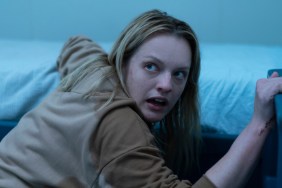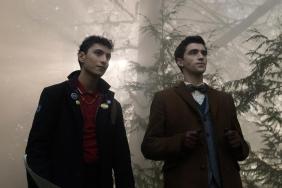In 2002, Neil Gaiman’s novel Coraline was published by Harper Collins, going on to win Hugo, Nebula and Bram Stoker awards, as well as being translated into 30 difference languages. The novel was compared favorably to a modern-day take on Lewis Caroll’s “Alice in Wonderland” filled with Gaiman’s normal dark imagery and clever wit as it told the story of Coraline Jones, a young girl whose parents have moved her into a strange old hotel with all sorts of bizarre inhabitants, and whose explorations lead to the discovery of another world that has similarities except that everything is generally better and brighter. After Coraline moves into this new world with her “Other Mother” (voiced by Terri Hatcher), she learns of the repercussions for her decision and finds herself having to save her normal parents and escape from this world.
Long before the novel became a success, director Henry Selick, whose groundbreaking work in stop-motion animation made Tim Burton’s The Nightmare Before Christmas a perennial classic, was working on adapting the novel as his next project. It took many years before Selick was able to get the movie off the ground, complicated by the fact that the director wanted to make this the first stop-motion animated feature film to be shot and projected using the latest 3D technology. With Dakota Fanning providing the voice of Coraline and Terri Hatcher as both her real mother and the evil “Other Mother,” Selick began what would end up taking almost eight years to complete.
ComingSoon.net spoke to Henry roughly four years ago, just before he started production, so it seemed only right we’d sit down to catch up with him as the bookend on the film’s completion.
ComingSoon.net: When we spoke four years ago, it seemed like you were at the early stages of developing this, so it’s nice to have a chance to talk to you at the end of that process.
Henry Selick: There was quite a ways to go. It was like a year and a half of pre-production and then 20 months of shooting and then a couple months of post. It was the biggest crew I’ve ever worked with. So rather than go quite as long, we added on a few more people to cut the overall shoot time down. It was a short 20 months.
CS: 20 months does seem short compared to how long it normally takes to develop a CG animated movie. Let’s go back a bit. I know you got the manuscript before the book was even published so you were already well into this before we last talked. Can you talk about when you first got the manuscript from Neil? Did you immediately start visualizing stuff you wanted to do with it or did you just read it as a regular reader?
Selick: I’d heard of Neil. I’d seen glimpses of “Sandman,” a comic series that he had been doing, but I wasn’t overly familiar. So I got the manuscript, it wasn’t yet published. I read it immediately, just the timing of how it was, and it’s a short read. It’s not a big novel, but I couldn’t put it down and I thought the most amazing thing was I could see the movie the first time I read it. I was hooked with the general idea of everyone wishes for a different life at some point in your life. As a kid, you wish for different parents. You might have a friend and you wish that those people were your parents. So everyone imagines a better life is a universal theme and then the delicious details that Neil comes up with and describes so beautifully also triggered my imagination. It wasn’t a difficult prospect to imagine turning into a film. It just took a long time before we finally got to make it.
CS: I assume when you got the manuscript it didn’t have the Dave McKean illustrations, which are very much a part of Neil’s thing, the two of them having worked together so long.
Selick: It wasn’t for a ways later, maybe a year and a half that Dave did the first illustrations.
CS: So you didn’t have anything that might affect your vision of the characters at that point. Interesting.
Selick: Neil’s book he had sort of the same problems and issue getting it published. Is it too scary for kids? Is it too childish for adults? The same problems I’ve had in getting the film made. One helped the other actually in setting up Bill Mechanic, the former head of 20th Century Fox, and his company Pandemonium, helped get it published. That’s what Neil’s lit agent Merrilee Heifetz told me recently. It’s always been at this crosspoint. We think that it actually works for both audiences and it has. It’s proven itself as a novel to work for his older fans and for kids. They like to see a kid, you know, 9, 11, 12 years old in great jeopardy that defeats the evil.

CS: It’s actually one of my favorite non-comic works by Neil. I bought it and read it in one sitting when it first came out, before I last talked to you, so I was excited to see how it would be visualized. Now, you’ve expanded some of the characters from the original book, and you’ve also added characters. For instance, Coraline’s friend is completely new to the movie. Was this something from the very early stages, you knew you wanted to do different things with the movie?
Selick: My first draft of the screenplay I did when I was adapting it, I was actually too faithful to the book and I was checking in with Neil. He’s an incredible writer and he was a little intimidating. It felt like I needed a lot of approval, but at the end when I finished it, nobody was happy with that first draft, including Neil, even though it was very close to his book. At that point I said, “You know what? I’m going to go again, but I can’t talk to you for as much as it takes.” It was about a year ’cause I was doing other things, but I was writing, and ultimately I needed someone else for Coraline to relate to in the real world. You know, we had a cat which is a super-important character, who can’t speak in the real world, so Whitey sort of grew into shape as that other kid. Then there’s the better version of him in the other world which she finds a way to like him, because it’s a version that can’t talk. So that’s probably the biggest change. The other characters, some things have shifted or adjusted.
CS: Bobinsky does kind of have a bigger part. At least in the real world you see a bit more of him, his background and stuff like that which is interesting, too.
Selick: Bobinsky, there’s the upstairs neighbor in the book, and at the end of the book we learn his name. It’s Bobo. I made it more specifically Russian and called him Bobinsky. This is a case where we designed the character and started exaggerating him and turned him into like an eight foot tall blue giant, and he was just so captivating as a character that he just earned more time. You know, it was a lot of fun to animate and watch him move and McShane did a really great job with the vocal performance. Brad Schiff, who did most of the animation of Bobinsky, did a fabulous job, so he kind of grabbed onto a little bit more of the movie than we planned on, and I think it worked.
CS: Oddly, there are things I love about the movie that aren’t really in the book, like Bobinsky’s mouse circus is my favorite part of the movie since in the book, even though there’s talk, you can’t really show that in the book, but it looks great. As far as being faithful to Neil, obviously the book has so many fans who would probably think it’s sacrilege to change what Neil wrote, though I’d imagine he’d be the first person to have you change things.
Selick: If we made the film almost immediately after first setting up the book, then it probably would’ve (been different)… the first draft was too faithful to the book, the second draft when I did start changing things more, everyone liked it better and wound up being produced. So there were big differences, but just in the amount of time, the film has taken on a life of its own. It’s not as if every change was necessary, but sometimes films dictate their own needs. Yeah, there’s quite a few differences, some very subtle and I am concerned about the fans. Neil’s very happy with the final film; I think most of his fans will be pleased with it.
CS: Earlier, you talked about how there were worries about this being too scary for kids, and how you wanted to balance it for kids and adults. Was that something very much in your mind the whole time while you were making this as far as how far to go with how scary the characters would be in the other world?
Selick: It was in my mind that I always wanted to respect the book and hold onto as much as I could, but in getting people to put up money for a film, there’s also great fear that comes with the money. So a lot of it was more other people’s concern that it was too scary, and I think I made adjustments that I think were addressed their concerns, but were also good for the movie. In the book, Coraline goes to this other world and immediately this mother is very strange. It could be pretty creepy right from the start and I just had to hold back on that except for the buttons for eyes, I wanted the other world I wanted everything to seem better and then over time reveal just start at a more innocent place aside from the buttons for eyes and little moments of real strangeness, and then change the mother dramatically when she’s revealed in her true form. In the book, Neil’s a brilliant writer, so he can describe something as just, “Her teeth were a tiny bit longer.” And it’s chilling.

CS: Right. (Laughs) That’s hard to do visually. I wanted to ask about the 3D aspect of the movie. Was it always meant to be a 3D movie? When did the 3D come into play?
Selick: I’ve been aware of 3D and how it’s been evolving for 20 years because I happened to work with this guy Lenny Lipton who’s pretty much the godfather of modern 3D technology. It’s just happenstance, but I was brought in to do a little rock video in 3D for him 22 years ago in California near where I worked. So I was kind of amazed. It was a crude system back then, but it was through the Viewmaster Corporation. It moved 3D along in other mediums beside their little viewers, and I was so impressed with what Lenny was doing. I would check in with him every few years to see how things were developing. So maybe two years before we finally started making “Coraline,” I did my check in and it got to a mind boggling state. I went to our main producer Bill Mechanic and he said, “Well, it may look good, but it’s not viable if it’s not in the theaters.” Then in the ensuing time, Lenny teamed up with this company Real-D to start installing their systems in theaters and now there’s about 1,400 theaters in North America. Anyways, so it was always in the back of my mind. This film went through its own evolution of what medium are we going to shoot it in, getting back to where it always should’ve been 3D captures stop-motion better than anything because it’s real puppets, as you can see, real textures, real props. Then ultimately I was looking for that “Wizard of Oz” moment where Dorothy goes from her black and white bland world into color. In that era, just going into color was a huge thing, so it just seemed like 3D is what we’ll use, but we’re not going to slam people over the head. It was bubbling along in the background through my connection to Lenny, and then it just so happened–waiting this long to make the film–a lot of that technology did actually get out there to the world.
CS: Was it challenging doing stop-motion using those cameras? They’ve been doing live action with 3D cameras on a couple films, but I imagine trying to do stop-motion with those cameras would impose all sorts of new challenges.
Selick: It added time ’cause you have to take two exposures and those were long exposures. Yeah, there were technical challenges and then there were artistic challenges – you know, there’s sort of the classic rules about 3D. The lenses are supposed to be about as far apart as your eyes are if you’re shooting live action, so whatever the distance between your eyes–the inner-ocular distance–but in miniature you have to make that much tighter so it’s on scale with the puppets, and you can’t get any lenses even that close. The good thing though in stop-motion is to frame it sometimes we would shoot the left eye and then the camera would move very slightly to the other eye, and then you can play with that. We can increase the depth sometimes, decrease the depth, and then you can move the whole 3D experience more in front of the screen or behind the screen. It took a few months to sort of get comfortable, “How is this not just a gimmick?”
CS: These days, you can actually playback what the 3D will look like on monitors on set, so are you able to do that when you’re shooting one frame at a time?
Selick: We couldn’t do it out on the stage where all the animation is shot, and we set up these miniature stages with black curtains. No, we couldn’t do it, but we tested everything. The tests went into our theater what we could project and sort of make a choice. Most of the lighters–we had lighting cameramen under the DP–they always wanted more 3D and I had to beat it down and say, “Save it, save it.”
CS: I know your company Laika is now doing a lot more CG animation as well. Were you incorporating some computer stuff into the process while doing this? There’s some stuff you can do obviously with computers that might be easier than stop-motion. Did you want to incorporate some of that into this or did you want to stay away as much as possible?
Selick: We certainly use CG post to composite things, but the marching orders were do as much as we can by hand. Use computers to enhance that or to help it, but at the end of the day look at the mouse circus. That’s all stop-motion, and that was a natural area where the producers, everyone said “Oh, that’s natural to just do CG,” and I said, “Yeah, but it won’t be special anymore because anyone can do that in CG and then suddenly the film will look like what everyone’s seen for 10 years.” So it was a battle, but everyone’s really happy we did the mouse circus that way. There’s hundreds of mice. (Laughs)

CS: Also the dogs watching the performance in the theater.
Selick: Yeah, that’s another thing. That was another battle. Or Coraline is just driving home with her mother from going shopping and they’re not getting along. That was another place, “Oh, just build it with CG background,” and I fought it. I said, “No, we have to build real backgrounds there as they’re driving along.” By far the greatest percentage of everything you see on screen was created by hand, but there’s beautiful, masterful CG enhancement. There’s one dream Coraline dreams of the ghost children who’ve been dead, but they’re kind of going to heaven or something good. The background there, I asked Tadehiro, our main concept illustrator to do his version of “Starry Night,” the Van Gogh painting. That was done in CG, we tried to do it in hand, it wasn’t working. That’s the most obvious CG.
CS: And obviously removing armatures and stuff like that.
Selick: Oh, yeah. We do digital paint removal where you shoot a clean plate after you’ve done the animation so you can remove metal rods that hold the puppet when the puppet jumps up in the air and all of those sorts of things.
CS: As the person who actually visualized and designed everything, was there any point where you don’t think the puppeteers, or the people who build the puppets might be able to bring these visuals to life? There’s so many things which you couldn’t even imagine someone would be able to do with puppets or stop-motion, so is there any point where you just work through the problems and figure it out as you’re shooting? How does that work?
Selick: You know, almost a third of the crew were veterans going back to “Nightmare Before Christmas.” So I had this really strong core of people. We wanted new challenges, we knew we could find ways to solve the problems. We had sort of one third veterans and maybe one third up and comers and new people. It took a while for the team to really pull together to we’re all on the same page. I’d say (Laughs) a month before we finished the film everyone knows exactly what they’re doing, but that’s normal.
CS: One thing I’ve noticed is that stop-motion and claymation are definitely having a bit of a resurgence. I guess it’s been happening for a while now in some ways. For instance, this year’s Sundance Film Festival opened with a Claymation movie. Having been doing this for so long, do you see stop-motion being an answer to the obvious amount of CG being used these days?
Selick: I guess it’s an answer. It was hard to do. I mean, even with “Nightmare” after the Pixar films came out and then when DreamWorks, after the “Shrek” film, it was very difficult to convince people to do stop-motion. Even if the films made money, people always want the biggest money. There was talk of a sequel of “Nightmare” some years ago, but it would be all CG, and I said, “Well, why would you do that?” The resurgence I think comes as much from the artists and filmmakers and their strong desire to work in that medium. We have neophytes who have come into it: Wes Anderson’s directing “The Fantastic Mr. Fox” as a stop-motion film; they set up a company in London with lot of the people who worked on “Corpse Bride.” The costs of these films is substantially less than the high-end CG films, so that’s attractive. Then finally, you look at a film, “Nightmare” above all the other things I’ve worked on, it’s an evergreen property that never seems to get old. It doesn’t seem dated and I think stop-motion has that. There’s something unique about it that’s timeless. I can’t explain why; I’ve thought about it, but yeah, there’s more stop-motion films in the works. There’s a resurgence in particular lately just – we’ve seen perfect CG effects, we seen amazing CG films, now it’s not the fact that it’s CG that has any appeal anymore.
CS: Would you think most people–kids probably not–but when they go see a movie like this, do you think they notice the difference between a movie that’s done stop-motion or via CG. I’m curious how many people can go in fresh without knowing anything and be aware that it’s being done stop-motion vs. CG.
Selick: I’m sure plenty of folks, they’ll feel the difference even if they can’t say. They’ll look at clips of “Coraline” because we paint out this there’s a crack in her face where her upper face was replaced differently from her lower face so we get a huge range of expressions. See, I would’ve left that in because I want people to know that it’s hand-made, but I think they feel the difference even if they don’t know literally that it’s one medium over another.
CS: Having spent roughly eight or nine years developing this movie, have you had any time to think about other projects? Do you have any idea what you might do next or are you just going to relax for a bit?
Selick: Yeah, I mean, I met Neil and I wrote my first draft, and then I wrote my second, and I worked on other things. The film wasn’t coming together and it wasn’t until four years ago that we hooked up with Focus Features who believed in the project enough to be our distributors, and found a studio in Portland, Oregon that believed in the film, and put a team together. So the last four years are a lot better than this, but yeah, there’s a couple things. There’s a Philip Pullman book from before “The Golden Compass” called “Count Karlstein” that I’ve done some development work on that I’m interested in. There’s an original story by my storyboard artist, a really talented guy named Chris Butler called “Paranorman.” It’s a very funny zombie story. I’m trying to help him, support him as a director, probably pair him with someone else as a co-director. So there’s a couple of things crawling along, but we’ve gotta get “Coraline” out to the world first.
CS: Do you have any aspirations to direct any more live action movies?
Selick: Never. (Laughs) No, no, live action sort of came into it sideways and I’m glad I escaped with my life.
Coraline opens nationwide on Friday, February 6. You can also read an interview with Terri Hatcher on her roles in the movie here.









